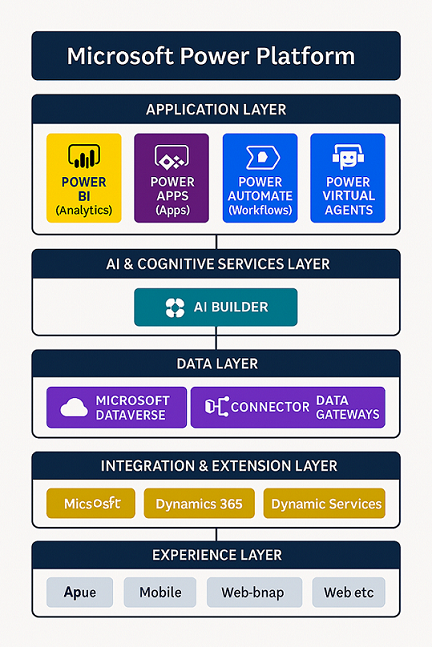Microsoft Power Platform is a suite of low-code/no-code tools that empowers users to analyze data, build apps, automate workflows, and create intelligent virtual agents. It includes Power BI, Power Apps, Power Automate, and Power Virtual Agents, all seamlessly integrated with Microsoft 365, Azure, Dynamics 365, and hundreds of data connectors. It enables both citizen and professional developers to rapidly deliver business solutions. The platform is powered by Dataverse, providing a secure and scalable data backbone.
Microsoft Power Platform Architecture

Application Layer – Where users build apps, dashboards, workflows, websites, and chatbots.
- Power BI
- Interactive dashboards and reports
- Visual data exploration and storytelling
- Power Apps
- Low-code/no-code app development
- Canvas apps (custom UI), Model-Driven apps (data-first)
- Power Pages for external-facing websites
- Power Automate
- Automates repetitive workflows
- Types: Automated, Instant, Scheduled, Desktop (RPA)
- Power Virtual Agents
- No-code chatbot builder
- Integrates with Teams, websites, and more
- Power Pages
- Build secure, data-driven web portals
- Connects with Dataverse for real-time content
AI & Cognitive Service Layer – Adds intelligence through machine learning and cognitive services.
- AI Builder
- Prebuilt AI models (form processing, object detection, prediction, sentiment analysis)
- Integrates into apps and flows
- No machine learning expertise needed
Data Layer – Manages secure data storage and connectivity across systems.
- Microsoft Dataverse
- Central cloud-based relational data store
- Handles schemas, relationships, roles, and metadata
- Connectors
- 700+ built-in connectors for SQL Server, SharePoint, Dynamics, Salesforce, etc.
- Enables integration with external APIs and services
- Data Gateways
- Connect on-premises data to Power Platform
- Essential for hybrid cloud scenarios
Integration & Extension Layer – Expands platform capabilities by integrating with Microsoft and third-party ecosystems.
- Microsoft 365
- Embeds Power Platform tools in Outlook, Excel, Teams, and SharePoint
- Boosts productivity and collaboration
- Dynamics 365
- CRM & ERP systems with native Power Platform integration
- Share data and functionality seamlessly
- Azure Services
- Extend with Azure Functions, Logic Apps, App Services, Cognitive Services
- Used for advanced development and scaling
- GitHub & Azure DevOps
- CI/CD support for automated deployments
- Enables version control and team-based development
Experience Layer – Where end users interact with Power Platform apps and insights.
- Web Interfaces
- Run apps and dashboards in browsers
- Supports Power Pages and Canvas Apps
- Mobile Interfaces
- Access Power Apps via iOS and Android
- Responsive design across devices
- Microsoft Teams Embedding
- Add apps, dashboards, and bots into Teams channels
- Drives collaboration inside chat/work hubs
- Embedded Analytics
- Integrate Power BI visuals in apps, SharePoint, websites
- Enables real-time, contextual insights
- Web Snap-Ins / Progressive Apps (Web-BNAP)
- Browser-based native application platform—also referred to as BNAP or PWA (Progressive Web Apps).
- Offers app-like experience in browsers without installing anything
- Power Pages and Canvas Apps can be deployed as PWAs, enabling offline access and mobile-first performance
- APUE (Advanced Programming in the UNIX Environment)
- Though not a native part of Microsoft Power Platform, APUE builds the system-level foundation behind many enterprise-grade integrations.
- Backend Support for Azure Functions & APIs
- DevOps and CI/CD Pipelines
- Secure API Gateways and Gatekeeper Services